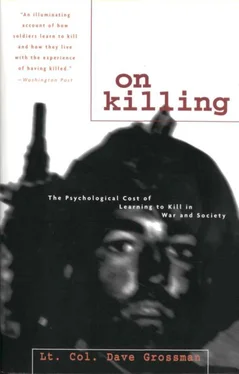Over the centuries there have been a few pioneers who have laid the foundation for such a study, and in this section we will attempt to look at them all. Probably the best starting point is with S. L. A. Marshall, the greatest and most influential of these pioneers.
Prior to World War II it had always been assumed that the average soldier would kill in combat simply because his country and his leaders have told him to do so and because it is essential to defend his own life and the lives of his friends. When the point came that he didn’t kill, it was assumed that he would panic and run.
During World War II U.S. Army Brigadier General S. L. A. Marshall asked these average soldiers what it was that they did in battle. His singularly unexpected discovery was that, of every hundred men along the line of fire during the period of an encounter, an average of only 15 to 20 “would take any part with their weapons.” This was consistently true “whether the action was spread over a day, or two days or three.”
Marshall was a U.S. Army historian in the Pacific theater during World War II and later became the official U.S. historian of the European theater of operations. He had a team of historians working for him, and they based their findings on individual and mass interviews with thousands of soldiers in more than four hundred infantry companies, in Europe and in the Pacific, immediately after they had been in close combat with German or Japanese troops. The results were consistently the same: only 15 to 20 percent of the American riflemen in combat during World War II would fire at the enemy. Those who would not fire did not run or hide (in many cases they were willing to risk great danger to rescue comrades, get ammunition, or run messages), but they simply would not fire their weapons at the enemy, even when faced with repeated waves of banzai charges. [3] There has been considerable controversy concerning the quality of Marshall’s research in this area. Some modern writers (such as Harold Leinbaugh, author of The Men of Company K), are particularly vociferous in their belief that the firing rate in World War II was significantly higher than Marshall represented it to be. But we shall see that at every turn my research has uncovered information that would corroborate Marshall’s basic thesis, if not his exact percentages. Paddy Griffith’s studies of infantry regimental killing rates in Napoleonic and U.S. Civil War battles; Ardant du Picq’s surveys; the research of soldiers and scholars such as Colonel Dyer, Colonel (Dr.) Gabriel, Colonel (Dr.) Holmes, and General (Dr.) Kinnard; and the observations of World War I and World War II veterans like Colonel Mater and Lieutenant Roupell — all of these corroborate General Marshall’s findings. Certainly this subject needs more research and study, but I cannot conceive of any motive for these researchers, writers, and veterans to misrepresent the truth. I can, however, understand and appreciate the very noble emotions that could cause men to be offended by anything that would seem to besmirch the honor of those infantrymen who have sacrificed so much in our nation’s (or any nation’s) past. The latest volley in this ongoing battle was on the side of Marshall. His grandson, John Douglas Marshall, in his book Reconciliation Road put forth one of the most interesting and convincing rebuttals. John Marshall was a conscientious objector in the Vietnam War and was completely disowned by his grandfather. He had no cause to love his grandfather, but he concludes in his book that most of what S. L. A. Marshall wrote “still stands, while much of the way he lived deserves criticism.”
The question is why. Why did these men fail to fire? As I examined this question and studied the process of killing in combat from the standpoints of a historian, a psychologist, and a soldier, I began to realize that there was one major factor that was missing from the common understanding of killing in combat, a factor that answers this question and more. That missing factor is the simple and demonstrable fact that there is within most men an intense resistance to killing their fellow man. A resistance so strong that, in many circumstances, soldiers on the battlefield will die before they can overcome it.
To some, this makes “obvious” sense. “Of course it is hard to kill someone,” they would say. “I could never bring myself to do it.” But they would be wrong. With the proper conditioning and the proper circumstances, it appears that almost anyone can and will kill. Others might respond, “Any man will kill in combat when he is faced with someone who is trying to kill him.” And they would be even more wrong, for in this section we shall observe that throughout history the majority of men on the battlefield would not attempt to kill the enemy, even to save their own lives or the lives of their friends.
CHAPTER ONE
Fight or Flight, Posture or Submit
The notion that the only alternatives to conflict are fight or flight are embedded in our culture, and our educational institutions have done little to challenge it. The traditional American military policy raises it to the level of a law of nature.
— Richard Heckler
In Search of the Warrior Spirit
One of the roots of our misunderstanding of the psychology of the battlefield lies in the misapplication of the fight-or-flight model to the stresses of the battlefield. This model holds that in the face of danger a series of physiological and psychological processes prepare and support the endangered creature for either fighting or fleeing. The fight-or-flight dichotomy is the appropriate set of choices for any creature faced with danger other than that which comes from its own species. When we examine the responses of creatures confronted with aggression from their own species, the set of options expands to include posturing and submission. This application of animal kingdom intraspecies response patterns (that is, fight, flee, posture, and submit) to human warfare is, to the best of my knowledge, entirely new.
The first decision point in an intraspecies conflict usually involves deciding between fleeing or posturing. A threatened baboon or rooster who elects to stand its ground does not respond to aggression from one of his own kind by leaping instantly to the enemy’s throat. Instead, both creatures instinctively go through a series of posturing actions that, while intimidating, are almost always harmless. These actions are designed to convince an opponent, through both sight and sound, that the posturer is a dangerous and frightening adversary.
When the posturer has failed to dissuade an intraspecies opponent, the options then become fight, flight, or submission. When the fight option is utilized, it is almost never to the death. Konrad Lorenz pointed out that piranhas and rattlesnakes will bite anything and everything, but among themselves piranhas fight with raps of their tails, and rattlesnakes wrestle. Somewhere during the course of such highly constrained and nonlethal fights, one of these intraspecies opponents will usually become daunted by the ferocity and prowess of its opponent, and its only options become submission or flight. Submission is a surprisingly common response, usually taking the form of fawning and exposing some vulnerable portion of the anatomy to the victor, in the instinctive knowledge that the opponent will not kill or further harm one of its own kind once it has surrendered. The posturing, mock battle, and submission process is vital to the survival of the species. It prevents needless deaths and ensures that a young male will live through early confrontations when his opponents are bigger and better prepared. Having been outpostured by his opponent, he can then submit and live to mate, passing on his genes in later years.
Читать дальше







